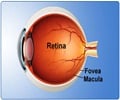The loss of retinal blood flow is also called retinal non-perfusion. This is caused by loss of small blood vessels or capillaries in the retina of the eye.

A follow-up study has shown that these peripheral lesions, which are not detected by traditional eye imaging, correlate very closely with the loss of retinal blood flow called retinal "non-perfusion" caused by loss of small blood vessels or capillaries.
In the recent research, the scientists used ultra-wide-field (UWF) imaging to examine the eyes of 37 patients with diabetes and varying levels of retinopathy ranging from no disease to very advanced disease. UWF retinal imaging can view more than 80% of the retina in a single image. In comparison, traditional clinical retinal imaging combines seven smaller photos to cover about a third of the retina, said Paolo Silva, ophthalmologist.
Areas of non-perfusion were identified by UWF retinal angiography, which detects blood flow after patients are injected with a fluorescent dye. The areas of non-perfusion matched up very closely with the peripheral lesions detected when these patients' eyes were scanned by normal UWF imaging, he emphasizes.
“The most surprising result was how very closely associated these two areas seemed to be,” said senior author Lloyd Paul Aiello.
He says that discovery raises the possibility that clinicians might be able to use the peripheral lesions to estimate the extent and location of the non-perfusion damage and the risk of disease progression without necessarily resorting to UWF angiography in every case. The study appears in Ophthalmology.
Advertisement














